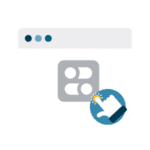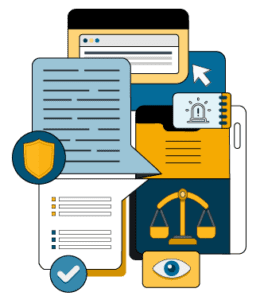Limit website tracking
How to protect your personal information
Delete browsing data
You may not want personalized ads based on your past website activity. You can delete cookies and clear your search and browsing history using your browser’s settings. A cookie is a small file on a website you’re visiting that remembers what you did on that site.
Deleting your browsing data makes it more difficult for websites to recognize you and connect your past online history. For example, you may need to login or add items into a shopping cart again. Remember that deleting your browsing data only clears your past activity – it does not prevent future tracking. Here’s how to delete your browsing data:
-
-
-
Open your browser’s privacy settings
Open your browser. Look for the menu icon (usually three dots or lines in the top corner) and select it, then choose Settings or Preferences from the menu. Then, find the section related to privacy. This can be called Privacy, Privacy and Security, History, or something similar.
-
Choose what you want to delete
Look for a button or link that says Clear browsing data, Clear history, or Delete cookies. Select Browsing history to erase the list of websites you’ve visited. Choose Cookies to remove small files that save your information and settings. Select Cache to delete saved website content that helps pages load faster.
-
Pick a time range and clear your data
Decide how far back you want to clear your data. Different browsers may offer different options, including clearing the history for the past hour, past day, or all time. Then click the button that says Clear, Delete, or Remove to finish.
-
-
Block third-party cookies
Once you’ve deleted your past history, you can work to make your future activity more private. Many websites also use third-party cookies that store information about you. Third-party cookies let other businesses save cookies in your browser that they can use to track your activity across other websites. You can block third-party cookies to keep your browsing more private.
To block third-party cookies, go into your browser’s privacy settings. Look for settings related to Cookies, Tracking, or Site data. Select the option to block third-party cookies and turn it on. This setting can also be called Prevent cross-site tracking or Enhanced tracking protection.
Adjust your privacy settings
Toggle your privacy preferences

One way to exercise your privacy choices may be through a toggle or button. You can use that toggle and opt-out of the selling or sharing of your information. Businesses are not allowed to show toggles or buttons that are confusing to you. They should clearly indicate your choice. You can also use an opt-out preference signal. It will automatically tell businesses that you do not want your information sold or shared.
Click the link
 If a business sells or shares your personal information, or uses your sensitive personal information, they should have a link on their homepage. You can use this link to make choices about your privacy.
If a business sells or shares your personal information, or uses your sensitive personal information, they should have a link on their homepage. You can use this link to make choices about your privacy.
The link could be called Do Not Sell or Share my Personal Information, Limit the Use of My Sensitive Personal Information, Your Privacy Choices, or Your California Privacy Choices. The link should take you to a page where you can control your privacy rights.
Read a business’s privacy policy
Businesses that must comply with the CCPA are required to post their privacy policy through a link using the word “privacy” on their homepage and other webpages. The link can usually be found at the bottom of a business’s website. For mobile apps, a link to the privacy policy also must be available on the platform or download page for the app and also may be in the app’s settings menu.

Learn what the business is doing with your data.
Reading these policies will help you better understand which categories of information a business is collecting, why they are collecting that information, and, if they sell or share that information, which category of information was sold or shared, and with which type of business. Sometimes a business isn’t selling or sharing your information at all.
Learn how to exercise your rights.
Find the section on California or that describes how consumers like you can exercise your privacy rights, such as deleting the information a business has collected from you or correcting the information the business has about you. This information must be easy to read and accessible. All privacy policies must include a method for you to contact the business if you have any questions or concerns about their privacy policy and information practices.
If the privacy policy is hard to find, not existent, or doesn’t provide an easy method for you to exercise your rights, submit a complaint with CalPrivacy.
Use privacy-centric browsers or extensions
Certain web browsers offer more privacy settings to control what websites can collect about you. You can check trusted reviews for recommendations. Some browsers may offer a “Private” or “Incognito” mode that deletes your browsing history after you close it, though businesses can still collect information about your activity while you are on their website.
There are third-party extensions or plug-ins that can provide more control over your privacy, such as ad blocking. Ad blockers help block trackers, pop ups and unnecessary cookies. Read reviews from trusted sources to learn about the features and choose an ad blocker that meets your needs.

